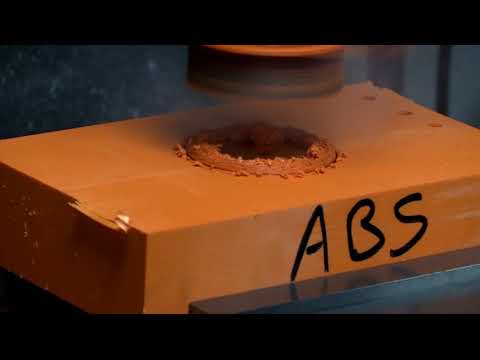Can You Use A Hole Saw On Plastic? If you’ve ever tried using a hole saw on plastic, you know that it can be quite difficult. The material is just too hard and the teeth on the hole saw can’t get a good grip. But with the right technique, you can use a hole saw on plastic without any problems.
- Select the right size hole saw for your project
- Attach the hole saw to your drill
- Drill a pilot hole in the plastic before using the hole saw
- Use a slow speed when drilling with the hole saw to avoid overheating and melting the plastic
- Apply pressure evenly while you are drilling to prevent the drill bit from walking across the surface of the plastic
- Cut through the plastic slowly and carefully to avoid cracking or breaking it
How to cut a hole in plastic using a hole saw
Can You Cut Plastic With a Hole Saw?
If you’re looking to cut plastic, a hole saw is a great option. But there are a few things you need to keep in mind when using one. First, make sure the hole saw is the right size for the material you’re cutting.
If it’s too small, it won’t be able to cut through the plastic. And if it’s too large, it will cause damage to the material. Second, set the speed of the drill properly.
If you go too fast, the hole saw can overheat and melt the plastic. Too slow and it will just tear through the material. Finally, use a lubricant like WD-40 or vaseline on both the hole saw and the piece of plastic you’re cutting.
This will help prevent damage to both tools and ensure a clean cut.
Can You Use a Metal Hole Saw on Plastic?
No, metal hole saws are not recommended for use on plastic. This is because the metal teeth on the hole saw can cause damage to the plastic material. In addition, using a metal hole saw on plastic can also create safety hazards since the sparks produced by the metal cutting action can easily ignite any nearby flammable materials.
What Tool Do You Use to Make a Hole in Plastic?
If you need to make a hole in the plastic, you have a few different options for tools. You can use a hand drill, an electric drill, or a Dremel tool. A hand drill is the most basic option and will require some manual labor on your part.
You’ll need to brace the plastic so it doesn’t move while you’re drilling and be careful not to apply too much pressure, which can cause the drill bit to slip. An electric drill is more powerful than a hand drill and will make the job easier. Be sure to use a drill bit that is made for drilling through plastic – these are usually labeled as “high-speed steel” or “cobalt.”
A Dremel tool is another option for making holes in the plastic. These tools are very versatile and can be used for many different purposes; however, they can be more expensive than other options. When using a Dremel tool, you’ll want to attach a cutting wheel that is made specifically for cutting through the plastic.
How Do You Drill a Hole in Plastic Without Cracking It?
When it comes to drilling a hole in the plastic, there are definitely a few things you need to keep in mind in order to avoid cracking the material. For one, it’s important to use a sharp drill bit – dull bits can cause the plastic to crack. It’s also important to go slowly at first and then increase speed once the bit has pierced through the surface of the plastic.
Finally, be sure to apply gentle pressure when drilling – too much force can also cause the plastic to crack. If you follow these tips, you should be able to drill a hole in plastic without any issues!

Credit: www.reddit.com
Plastic Cutting Hole Saw
Plastic cutting hole saws are designed to make clean, precise cuts in plastic materials. They are typically made of high-speed steel or tungsten carbide and feature sharp teeth that cut through plastic quickly and easily. Most hole saws have a small pilot drill bit in the center of the blade that helps to start the cut and keep the saw from wandering.
When choosing a plastic cutting hole saw, be sure to select one with a diameter that is appropriate for the thickness of the material you will be cutting. Hole saws can be used with a hand drill, power drill, or milling machine. When using a hole saw, it is important to apply steady pressure and use slow, even strokes to avoid breaking or damaging the blade.
4 Inch Hole Saw for Plastic
If you’re looking for a 4-inch hole saw for plastic, then you’ve come to the right place. In this blog post, we’ll provide detailed information about what to look for when choosing a hole saw for plastic, as well as some of our top recommendations. When choosing a hole saw for plastic, it’s important to consider the type of material you’ll be cutting through.
For example, if you’re cutting through the thin plastic sheeting, then you won’t need a very powerful hole saw. However, if you’re cutting through thicker plastics or even acrylics, then you’ll need a more powerful hole saw that can handle the tougher material. There are two main types of hole saws for plastic – those with carbide-tipped blades and those with diamond-tipped blades.
Carbide-tipped blades are great for general-purpose cutting and will work well on most plastics. Diamond-tipped blades are designed specifically for tougher materials like acrylics and Lexan polycarbonate sheets. If you’re not sure which type of blade you need, then it’s always best to err on the side of caution and choose a carbide-tipped blade.
Now that you know what to look for in a 4-inch hole saw for plastic, here are some of our top recommendations: The Milwaukee 49222064 is a great all-purpose carbide-tipped blade that will work well on most plastics. It has a depth of cut of 1-1/8 inches and an overall diameter of 4 inches.
For something specifically designed to cut through tougher materials like acrylics and polycarbonate sheets, take a look at the Dewalt DWASHRIRSET (10-piece). This set includes both carbide and diamond-tipped blades so that you can tackle any job thrown your way. The largest blade in the set has an impressive 4-inch diameter – perfect for larger projects!
How to Cut a Circular Hole in Plastic Without a Drill
If you need to cut a circular hole in the plastic and don’t have a drill, don’t worry! There are several ways to do it without one. Here are a few methods:
Use a sharp knife
Place the blade of the knife at the edge of the plastic where you want to make your cut. Apply pressure and rotate the knife around the circumference of the circle. Be careful not to apply too much pressure or you may end up cutting yourself.
Use a hot glue Gun
Place a small dot of hot glue on the plastic where you want to make your cut. Quickly place the barrel of the glue gun against the dot of glue and rotate it around the circumference of the circle. The heat from the glue will melt through the plastic, making a clean cut.
Use a soldering iron
Place the tip of the soldering iron against the plastic where you want to make your cut and rotate it around the circumference of the circle. The heat from the soldering iron will melt through the plastic, making it clean-cut. Be careful not to use too much pressure or you may end up melting through the entire piece of plastic.
Use a utility knife
The best way to cut a circular hole in plastic using a utility knife is by using a hole saw. First, you will need to drill a pilot hole in the center of the plastic. Next, you will need to attach the hole saw to the drill and drill around the perimeter of the pilot hole. Finally, you will need to use the utility knife to cut out the center of the hole.
Conclusion
If you’ve ever tried using a hole saw on plastic, you know that it’s not the easiest task. The material is slippery and can easily slip out of the saw, making for a dangerous and messy situation. However, there are a few ways that you can make this process easier and safer.
First of all, make sure to use a sharp hole saw. A dull one will just cause more problems. Second, use some tape to secure the plastic to the saw.
This will help to keep it in place and prevent it from slipping out. Finally, go slowly and be very careful. With these tips in mind, you should be able to successfully use a hole saw on plastic without any issues.

I’m John Carry, also known as a woodworker I have been a professional saw expert for over 10 years. I’d work with every type of saw machine out there, and experiment to find which tools work better.
I’m always looking for ways to improve my skills and help those around me. I love my job and am always happy to share my knowledge with others.


